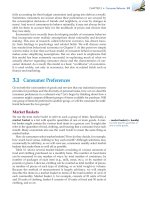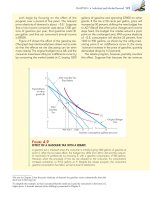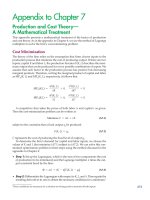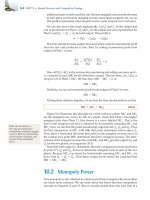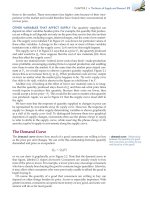(8th edition) (the pearson series in economics) robert pindyck, daniel rubinfeld microecon 123
Bạn đang xem bản rút gọn của tài liệu. Xem và tải ngay bản đầy đủ của tài liệu tại đây (89.86 KB, 1 trang )
98 PART 2 • Producers, Consumers, and Competitive Markets
for this relatively high income group, making additional money does not improve a person’s ability to
enjoy leisure time and good health—all of which factor into one’s overall well-being.11
These results offer strong support for the
modern theory of economic decision making
that underlies this text, but they are still being
carefully scrutinized. For example, they do not
account for the fact that satisfaction tends to vary
with age, with younger people often expressing
less satisfaction than older folks. Or we can look
at this a different way. Students have something
positive to look forward to as they get older and
wiser.
A second issue arises when we compare the results
of happiness studies over time. Per-capita incomes
in the U.S., U.K., Belgium, and Japan have all risen
substantially over the past 20 years. Average happiness, however, has remained relatively unchanged.
(Denmark, Germany, and Italy did show some
increased satisfaction.) One plausible interpretation
is that happiness is a relative, not absolute, measure
of well-being. As a country’s income increases over
time, its citizens increase their expectations; in other
words, they aspire to having higher incomes. To
the extent that satisfaction is tied to whether those
aspirations are met, satisfaction may not increase as
income grows over time.
Rationing
In times of war and other crises, governments sometimes ration food, gasoline,
and other products, rather than allow prices to increase to competitive levels.
During World War II, for example, individual households in the United States
were limited to twelve ounces of sugar per week, one pound of coffee every five
weeks, and three gallons of gasoline per week. Rationing has often been used
with respect to water in periods of drought. Within the United States, California
has often faced water rationing for both household consumption and agricultural production. Outside the United States, countries such as Rwanda, India,
Pakistan, and Egypt have imposed water rationing as recently as 2010.
Nonprice rationing is an alternative that some consider more equitable than
relying on uncontested market forces. Under a market system, those with higher
incomes can outbid those with lower incomes to obtain goods that are in scarce
supply. However, if products are rationed through a mechanism such as the
allocation of coupons to households or businesses, everyone will have an equal
chance to purchase a rationed good.
To understand how we can analyze rationing using the basic consumer model,
let’s use the gasoline rationing that occurred during 1979 as an example. Following
the 1979 Iranian Revolution, oil prices jumped, but the United States imposed
price controls that prevented increases in the price of gasoline, resulting in shortages. Gasoline was allocated by long lines at the gas pump: While those who were
willing to give up their time waiting got the gas they wanted, others did not. By
guaranteeing every eligible person a minimum amount of gasoline, rationing can
provide some people with access to a product that they could not otherwise afford.
But rationing hurts others by limiting the amount of gasoline that they can buy.12
We can see this principle clearly in Figure 3.22, which applies to a woman
with an annual income of $20,000. The horizontal axis shows her annual consumption of gasoline, the vertical axis her remaining income after purchasing
11
Daniel Kahneman and Angus Deaton, “High Income Improves Evaluation of Life But not
Emotional Well-Being,” PNAS, Vol. 107 (September 21, 2010): 16489–16493.
12
For a more extensive discussion of gasoline rationing, see H. E. Frech III and William C. Lee,
“The Welfare Cost of Rationing-by-Queuing Across Markets: Theory and Estimates from the U.S.
Gasoline Crises,” Quarterly Journal of Economics (1987): 97–108.

